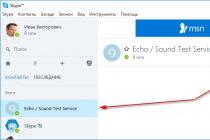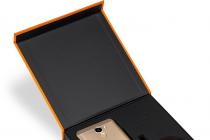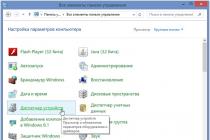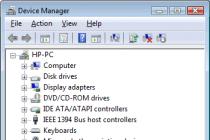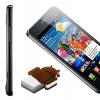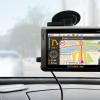This post is my own opinion and experience of using Preview Windows assemblies 10 Mobile from a site user.
Many regular readers in one way or another thought (and some decided) about switching to the preview version. I myself was a tester of three assemblies, and this article is intended to tell you about the unobvious and not immediately noticeable details of the new system, which for some may turn out to be critical.
This material is primarily intended for those who are not sure whether they should become an insider and test new builds themselves and send bug reports.
I have tested the system only for Microsoft Lumia 532, and in this article I will only reflect those aspects that are independent of the device. There is a chance that some items will disappear in build 10525, but from experience this is far from a fact.
pros:
1. Notification center.
This is the main advantage of the new system. This is access to an extended list of radio buttons, removal of individual notifications, the ability to respond in notifications. I believe that this is how it should have looked since Windows phone 8.1. It remains to make it translucent as in the table top ten.
2. Start screen.
The appearance of the desktop and the list of applications also deserves praise and the question "Why not do this right away?" It seems that this change is insignificant, but only at first glance - it was the same with the picture over the tiles in Windows phone 8.1.
3. Joystick on the keyboard.
A very cool alternative to moving the cursor using a magnifying glass on apple devices, which is one of the most convenient.
A feature that is sorely lacking in 8.1 when restoring from a backup. And the rest is a very competent approach to the implementation of the function. I would also like to see the download speed - sometimes it is useful.
5. New system applications.
I want to note right away that this does not apply to all applications, and not to the full. This plus is at the intersection of new features and new bugs. This includes new office applications, mail and calendar, music, calculator, alarms and clocks, and especially new browser... New applications for the phone, messages and contacts are called advantages, alas, the language does not turn out to be.
Minuses:
1. Scaling bugs.
Under this concept, I combine incomprehensible hyphenation of text in the store, very large or, on the contrary, very small interface elements, etc. It looks disgusting from all points of view. I really hope this is just a bug, not a feature.
2. Bug in the notification curtain.
Perhaps I'm picking on, but some of the additional icons cling to the gaze very much when the curtain is lowered, which then disappear. If this is done in order to show that they are there, then why the button "Expand"?
3. Keyboard bugs.
These are probably the most annoying bugs in the system. When typing text manually, instead of some letters, neighboring letters can be entered, and only with a certain sequence, i.e. in other cases, the letter is active; autocorrect often works incorrectly and often suggests words with a capital letter in the middle of a sentence. Personally, I am "tired" of changing "On" to "not" and vice versa; the keyboard itself is less than 8.1, possibly due to the same scale issues.
4. Incorrect background work of applications.
Everything here is very bad for those who are not advanced. If you do not correctly configure the background work of applications, then when the battery saver is on, you, for example, may not hear the alarm in the morning. In other words, what was protected from crooked hands can now end up in them. And even turning off the seemingly background work of applications, some of them can send push notifications.
5. New multitasking menu.
In the multitasking menu, compared to 8.1, the animation of closing applications is very slow. Combined with the absence of a "close all" button, this is a bit depressing. Also, when you open this menu in a horizontal orientation, you will only be able to close applications in it and do not rotate vertically.
6. Lock screen bug.
The screen after unlocking may not light up or light up immediately, while the date and time appear with a delay.
Many lament about the lack of Russian Cortana, but not many know that there is a fairly convenient voice control in Windows phone 8.1, which greatly simplifies the life of headset users. And this insanely useful feature has simply disappeared in Windows 10 Mobile.
8. Corrupted implementation of work with two SIM-cards.
In Windows phone 8.1, it is insanely convenient to work with two "sim cards". Thanks to switches and different color indications, it is simply impossible to confuse where you are making a call and where the SMS came from. In the mobile top ten it is done clumsily and absolutely not intuitively. Again, a nod to phone apps, messages and contacts.
In addition to what I have listed, there are other strong and problem areas of the new system, but I described only those that forced the rollback to the stable version of the system. There are also crashes and reboots, the battery eats as if not into itself. Perhaps the expense is associated with my device, but the very fact of working 3-4 times less from one charge makes you at least think about the advisability of being an insider.
Some of the points may seem like little things, but as Windows phone users, we are well aware that a positive user experience is all about little things.
The rejection of old solutions, which worked well, in favor of new ones, more convenient in theory, involuntarily bring back memories of Windows times Phone 7.5 and the wonderful Zune software, which has sunk into oblivion along with smart syncing (including Wi-Fi) and the ability to update the phone and download applications from the computer. And all for the sake of convenience of the mass-storage format and updates over the air. In the end, it was possible to leave both options for interaction.
Write in the comments what you fell in love with or what you were upset about in Windows 10 Mobile, as well as your comments and suggestions on the content of the article.
Despite Microsoft's best efforts, Windows 8.1 never became as popular as the company hoped. Probably, not least of all, this was influenced by the complexity of the task set by the software giant - Windows 8.1 is designed to work on computing systems of various form factors, not only on tablets. This circumstance, in particular, was associated with complaints from some users about the rapid discharge of the battery in Surface 2, but it should be noted that the company was able to quickly eliminate this shortcoming with the updated firmware. At the same time, according to James Kendrick of ZDNet, Microsoft's new OS has a number of advantages over one of its main competitors - Android.
Snap View mode. This is the multitasking mode in Windows 8.1, with which the user can run up to four applications at the same time on one screen. Each application has a minimum width and it can be adjusted based on the size of the screen. Android does not allow working on the same screen with several programs, which forced some manufacturers to modify the OS interface. For example, Samsung succeeded in this - the company added the Multi-View function, but it works only on some models of the Galaxy series tablets, moreover, it is limited to a few applications. Note that Multi-View supports portrait mode, while Snap View can only work in landscape orientation.
Updates. Android has become in many ways attractive in the eyes of customers due to its undemanding system resources and a lot of apps. But it has one significant drawback - fragmentation: updates to latest versions Android is received exclusively by devices of the Nexus line, updating other devices, even top-end ones, depends on the manufacturer's whim. To make matters worse, Android tablet owners are not getting more than Android updates, with which you can still live with, but also security patches. Owners of Windows 8 devices do not have these inconveniences by receiving updates as they are released.
Improving user experience. Android appeared before Windows 8, but the user experience, or, in other words, the skills that owners acquire with each new OS update, if they have changed, are not very significant. At the same time with Windows update 8.1 Microsft has demonstrated that it is able to quickly respond to user needs, eliminating some serious flaws in the original version of Windows 8, and the company is certainly preparing major changes for the upcoming Windows 9. It is possible that they will affect the interface of the system.
The smartphone version of Windows 10 is what we've all been waiting for. It is assumed that the new version of the OS will be shown in September - just a few weeks after the release of "dozens" for desktop computers. But isn't it all too late? ..
"Microsoft is giving up"
Many desktop and laptop owners have liked Windows 10 - but manufacturers, most users, and industry experts still shake their heads in doubt. Kantar analyst Carolina Milanese:
“The bottom line is that Microsoft - in my opinion - has given up trying to become a third ecosystem in smartphones and is now trying to make Windows users 10 worked with its services on other devices, regardless of the platform. "
Focus change

Milanesi believes that the recent restructuring at Microsoft suggests that the portfolio of devices from Microsoft Mobile will shrink significantly in the future. The new management, the analyst believes, will focus on the top Windows 10 Mobile smartphones and gadgets for corporate clients. All other types of devices will be produced by partners of Redmond.
The expert adds that the main problem of mobile Windows - a weak ecosystem - will not go anywhere with the arrival of Windows 10 Mobile. The current Microsoft, however, does not particularly care about it - the company simply offers its services to competing platforms and makes money not by selling gadgets, but thanks to the capabilities of its services.
According to IDC, in the first quarter of 2015, Windows Phone occupied only 2.7% of the global smartphone market. For comparison, Android has a similar indicator of 78%, iOS - 18.3%. This is slightly better than at the beginning of the year, but still not enough - after all, over the long years of its existence, WP has never managed to capture at least 5 percent of the market. The first partners of Microsoft - HTC and Samsung - have lost interest in the system (except for the "operator" smartphones for the United States). Today, apart from Microsoft itself, interest in Windows Phone is mainly shown by little-known companies that are unable to provide any significant supply and sales.
Fighting fragmentation

But for the majority of "faithful" (as in the text - ed.) Fans of Windows Phone, the upgrade to version 10 Mobile is great news, believes an analyst from Switzerland Ernest Doku. The expert is enough for Microsoft: the company offers software updates for both new and old devices - for the same Android, the situation is simply unthinkable. This is a plus for customers - they can quite easily purchase the cheapest Windows Phone, because even on it, you can enjoy many of the advantages of Windows 10 Mobile over WP 8.1.
Now Redmond, writes Doc, needs to make another correct move - to conquer the mobile market with the help of affordable smartphones... In Africa (especially sub-Saharan Africa) and Asia, $ 80 devices are often the only way to get online, and it would be at least unwise to neglect such growth opportunities.
Survive the harsh smartphone market
But like Milanesi, Doku wonders if Microsoft can make a difference in the mobile market. And if the release of Windows 10 Mobile still does not coincide with the announcement of new and very interesting smartphones, then everything can end very badly:
"... As always, hardware is the key to success, and a strong portfolio of devices is essential to keep Microsoft in the pricey and uncompromising smartphone game."
This material is difficult to write correctly. After reading more than a dozen reviews of mobile Windows 10, I came across approaches that are radically different: from the usual description of menus and their capabilities to an in-depth analysis of system codes from the point of view of developers and programmers. I wanted to approach this review a little differently, from different positions. Describe not only what the user receives today, but also where the development of the system can go, what ideas are embedded in it and what they can ultimately result in. One cannot exist without the other, and therefore, in addition to descriptive, specific moments with illustrations taken from Lumia devices, I will need to lean aside and describe what is not on this platform, but is present in the modern market. Why? The answer is obvious, the Windows 10 Mobile platform does not exist in an airless space, but competes for buyer's attention with systems such as Android / iOS. And only by understanding these differences, it will be possible to break out of the trap of the Microsoft worldview, which prefers to describe only what exists within their systems, and not pay attention to competitors.
Reasons for the emergence of Windows 10 Mobile - life from scratch for the third time
We are already living in the post-PC market, where the main page views on the web are from mobile devices rather than personal computers, be it a home system or a laptop. The irony is that one of the pioneers of this direction and the company that accurately predicted the course of events, but was slightly mistaken in the dates, was Microsoft. She never had a shortage of visionaries, people who could predict the development of the market and give accurate forecasts. The problem was in the execution of forecasts, their implementation in practice and the creation of a mobile version of Windows. There has always been one approach that can be called dominant within Microsoft, it has not changed for the last decade or more. The mobile operating system should be a copy of the desktop system and give the user a similar experience. So, when Windows Mobile appeared, users were convinced that it was ideologically the same system as on their computer, look, it even has a Start button! Many people bought Windows Mobile devices in order to realize that they are not at all like their computers, that they are in no way compatible with them or are almost incompatible and belong to a completely different class. portable devices... Nevertheless, at the dawn of the smartphone market, the role of Windows Mobile was quite serious, this system influenced the formation of Symbian, its ideology was considered by many to be promising.
But Microsoft made a number of serious mistakes, building a business model on cooperation with Chinese manufacturers that created Windows Mobile smartphones, the company launched the process of destroying its platform. Notable unit sales, programmers who rushed to create applications - everything whispered about the success of the undertaking. But the trouble came from the very Chinese who, in the battle among themselves, gave up on quality, as a result, the platform became associated with powerful, but buggy devices. The same Symbian lost functionally, did not develop so quickly, but it was guaranteed to work. The direction of Windows Mobile became a kind of cursed place inside Microsoft, there was no person who could present a coherent and detailed development plan. More precisely, there were too many such people, and each had their own plan of salvation. They, like in Krylov's fable, pulled Windows Mobile in their own direction. And the result was that the company suddenly realized that they were losing the market and could lose the race for the consumer. This was in the early days of Android's growth, around 2009, when the system first showed its potential and it became apparent even to die-hard skeptics. And at that moment Microsoft began throwing itself, which has not ended even today, the first zeroing of the company's mobile platform took place - the appearance of Windows Phone.
By and large, Windows Phone has become Microsoft's anti-crisis plan, a response to the conquest of the market by iOS / Android. At the 2010 congress in Barcelona, the company showed Windows Phone as an animated screensaver on dummies of future phones, no system existed, it had to be created in the coming months. We were all shown pictures that had nothing under them, and the choice of tools for developers, code for the mobile OS was chaotic, it was designed on the knee, just to have time to divide the pie in the form of end consumers. The only task that was set within Microsoft was to meet the deadlines; in a state of time trouble, the creation of the system could not be properly planned. The first devices of the Lumia series from Nokia had many problems, each of which was corrected in the course of the play, the most serious mistakes were corrected in the first few months of sales, and the "little things" were finished for about a year.
But within Microsoft, already in the first months of the life of Windows Phone 7 on the market, there was an understanding that this system was built incorrectly and that the core needs to be reworked, the transition to the source code, similar to the desktop version of Windows NT. In the future, this would allow the creation of the same applications for different branches of Windows, with minimal differences and effort. The decision was controversial, as the company's PR and advertising for the new platform promised that users would receive updates. But instead, a year later, the market received Windows Phone 8, and the enthusiasts and pioneers of the new system received version 7.5, in which they added external similarity to the 8th, but the key features were missing. Many people considered themselves cheated, as once again Microsoft zeroed out its mobile platform and started its life from a new point.
I want to draw your attention to the fact that all these years at Microsoft, the idea that a mobile system should be similar to a desktop OS has not disappeared anywhere. With perseverance worthy of a better application, the company implanted in phones an interface that few could call successful, it was unusual (Metro UI in the original name or tile), but not the best in terms of ergonomics.


The change in management of the company, the lack of striking success in the Windows Phone field, the murder of the tablet version of Windows RT - all these events took place during the existence of Windows Phone 8.x. And they showed inside Microsoft a simple thing: the system that the company created is not viable without subsidies for iron when it is sold below cost and only because of that it has 3% of the world market. Billions of dollars in marketing, the purchase of Nokia's mobile division - nothing made Windows Phone a success. The problems only got worse. And what was the next step? Microsoft did what they used to do - they decided to start life with blank slate.
The arrival of Windows 10 Mobile is a zeroing out of a deadlock Windows situations Phone 8.x, when the system did not receive any noticeable sales, and the few developers who wrote software for it constantly felt like outcasts. There is an opinion that those who are unable to create software for Andorid / iOS can write it for Windows Phone, where the quality of programs does not play a big role, since these programs are few and users are eager for them. Fish for bezrybe and cancer, as they say in our area.
Such a parameter as the cost of ownership of Windows Phone was noticeably higher for the end user than for Android / iOS, since in the absence of competition between the programs one could set any prices for them. For example, Microsoft paid for the development of the official Instagram client for Windows Phone, it was shown at one of the press conferences, and it seemed that this was the turning point when everyone would start writing for this platform. But it didn't work out. What's more, the official Instagram client for Windows 10 Mobile is still in beta in 2016! It lacks most of the settings available on other platforms, and it lacks support for working with video. The best alternative product 6tag does not know how to work with all filters, and to work with video you will have to pay 119 rubles. This is just a small touch that shows the state of affairs with software for Windows Phone.

Microsoft realized that it had lost the battle for the mobile market and went into a loss-minimizing mode. The arrival of Windows 10 Mobile is an attempt to take advantage of the key event of 2015, the release of the desktop version of Windows, which received the tenth number. Part of the success of Windows desktop was to kickstart and support mobile sales until the company came up with a new plan and zeroed it out once again to start from scratch.
In early 2015, when they showed Windows 10 Mobile, Microsoft told a very interesting thing - the launch of the system will take place later than the release of desktop Windows 10. Why? The answer was obvious - all efforts were devoted to the main product, and they would try to finalize it as soon as possible. Starting in October, after the launch of desktop Windows 10, most programmers will switch to the finalization of Windows 10 Mobile, and it will be brought to mind in a couple of months. Even then, I was confused by these words, it turned out that Microsoft lowered the priority of the mobile OS to the minimum.
But then they announced the Windows Insider program, which allowed you to become a beta tester. mobile system anyone who wishes. Fans of Windows Phone perceived this as a good attitude of the company towards them, pragmatists from business - as a reduction in development costs, shifting tests onto the shoulders of end users. This always leads to negative results, since testing must be carried out within the company, and only then can they give an adequate result.
Unfortunately, the number of end-user innovations that were shown in early 2015 for mobile Windows turned out to be so scanty as to cause dismay. In my material, I described them and expressed my bewilderment how you can wait almost a year to release such an update to the market.
Already at the time of the announcement, the system looked archaic, and the speed of development of Windows Phone compared to other systems turned out to be slower. In fact, Windows Phone not only remained a catching-up system, the rate of separation from it iOS / Android began to increase, over the past five years Microsoft has not been able to bridge this gap, or at least narrow it.
Initially, Microsoft plans to update almost the entire Lumia line to Windows 10 in November 2015, then the deadline was postponed to November, and then to early 2016. This is due to the fact that inside the company they realize that the current version of Windows 10 Mobile can hardly be called a beta version, it is unstable, has many problems and flaws, and even against the background of Windows Phone 7 is striking in the number of problems. The company could not help but release its flagships on Windows 10 Mobile, they were put into production, components were purchased for them. But at the same time, Microsoft is trying to minimize the damage from the launch of raw products as much as possible. Thus, the company does not distribute devices for testing if publications and journalists do not agree that they will not mention the disadvantages, but will focus only on the positive aspects. However, no one warns Lumia buyers that the system is flawed and cannot be called out of beta.
Unfortunately, the classic situation for Microsoft is repeated, the company will not be able to develop Windows 10 Mobile in 2016, since all efforts will be spent on fixing errors and working on firmware. This means that Microsoft needs to reduce the number of phones sold as much as possible, which the company has already officially announced. the lineup 2016 will be minimal and represented by several models. Removal of hardware subsidies, since there is no more competition for market share, why sell a crude product that will scare away users? And preparing for life from scratch, which will be the Surface Phone, although the name of this product can be anything.
It turns out that Windows 10 Mobile is another, another page in the history of the mobile platform from Microsoft, which can be considered a transitory and temporary one. The company does not make any serious plans regarding this system, to some extent they want to forget it as soon as possible in order to start building the “correct” system for the new time. But many people do not know this, do not understand and can buy Lumia smartphone... Let's take a look at the system itself and what it offers to its users today. Let's move on to describing the Windows 10 Mobile interface.
Windows 10 Mobile tiles and UI features
The originality of the Windows 10 Mobile interface is hard to deny, main screen consists of tiles different sizes, you can choose a small square, a larger square, or a rectangle. You need to hold the tile for the icons to appear, you can also pin the tile to the screen.

The screen has a vertical orientation, that is, the tiles must be scrolled down. You never know how many tiles you have in total, the screen can be conditionally endless. Given that most the applications you need easily fits on the main screen, it does not cause any problems. You can place everything you need here.
Unfortunately, in the area of customization, Windows 10 is far behind modern platforms, you cannot customize the color of individual tiles - just choose a color scheme for everyone. This can be confusing for those who are not familiar with the system and are used to the fact that WhatsApp has a green icon. On my phone, for example, the default color for all tiles is blue, and the WhatsApp icon is the same color.

Does this confuse people who are used to WhatsApp being green? Definitely. But this also creates certain difficulties for software developers; when advertising and promoting your application, you cannot achieve the uniformity that you expect. Why was it done in Windows? Apparently, they thought that the icons might be too variegated. Or they simply did not have time to do it, I don’t know. But the fact remains that you will not be able to customize everything for yourself. And the experience of other systems and the huge world outside Windows should be forgotten - here the icons will be in the color that you have chosen or for you.
In the "Options" section you can also choose to show more tiles or less, this setting adjusts the same size. There is a choice of wallpapers and transparency of tiles, interestingly, compared to Windows Phone 8.x, wallpapers appeared both on the center screen and in the list of applications.
Now an amazing moment, which remains a mystery to me. In desktop Windows, many functions have been duplicated in different menus so that the user can change the parameter in a matter of seconds. In mobile Windows, everything is different, to change the wallpaper, adjust the color of tiles, you need to go to the settings (this section is called "Options"). Not very logical and not very convenient. But, apparently, the developers proceeded from the assumption that it is not necessary to adjust the color of the tiles and wallpaper so often. There is a certain logic in this.

































Unfortunately, toggling the more / less tiles mode confuses the grouping of tiles on the screen when there are a lot of them. They unexpectedly line up not in three vertical rows, as before, but in two. It is possible that this glitch will be removed in the future, but it looks strange, the system does not remember the previous state.
Many tiles are animated and show information, for example, the mail tile scrolls the headers of new messages, there is a circle with the number of new messages. It is quite simple and informative, but this approach is rather an exception. In most cases, information is displayed chaotically, and there is no system in it, that is, you cannot assess at a glance what you missed or what happened. For example, news shows headlines, changing them one by one. Something similar was in widgets at the very beginning of the development of Android, then the system evolved, but this did not happen in Windows.
I do not presume to evaluate how the tile looks for the end user, you can get used to it and even love it. Evaluation of UI design is a matter of taste, here everyone will have their own opinion. I would like to dwell on how this UI manifests itself in work.
In standby mode for phones with AMOLED screens, it is possible to display information from certain applications, for example, a calendar. White inscriptions are brightly lit on a black background, for example, it may be a message that your friend has a birthday. You are free to choose the applications that will display information here. Plus, icons of missed events and time are shown.
This screen operation is convenient and allows you not to pick up the phone to see what was happening while you were doing other things. In blocking mode, when you have not yet entered the device, you can see information from other applications, for example, Twitter - as a rule, this is one entry. Therefore, we can consider it more a design element than something useful and really helping to navigate the flow of information.
The vertical orientation of the interface is due to the fact that the list of applications (swipe to the left) is better displayed this way. You see applications sorted alphabetically, there is a search bar at the top or a selection of letters, then you can jump to a specific section. The irony is that for users outside the US using two languages, the alphabet goes like this - first the local layout, then the English.



That is, English language almost always on the second screen, it turns out that you need to scroll the screen and only then select the desired letter. Ergonomics show in such little things, and in Windows 10 Mobile, it is lame on all four legs. Feeling like Microsoft's army of programmers was working on separate features and applications, but there was no chief architect to explain and show how all of these pieces should work together.
At the top of the list, the latest applications that you have installed on your device are shown.
By analogy with Android and iOS, Windows 10 has a curtain for notifications and quick activation of certain functions. You pull the screen down, 4 icons appear, each of which you can customize to your liking by choosing what you need from a list predefined by the manufacturer. You can expand the icons, then a 4x4 matrix will appear, but in the large matrix for three new rows it is no longer possible to select functions, they are determined by the manufacturer.


Notifications in the curtain are grouped by program, you can disable their display here for each application. For SMS / MMS there is a quick response from the shutter, you just need to type a text, and you can immediately send it.
Some notifications do not make any sense, for example, after a system update, this is reported in the shutter. Clicking on a notification doesn't show any information, meaning it's a dead end. There are a fair number of such messages, and why they are needed is decidedly unclear.
Those who use the phone actively and who lack space on the first screen can create folders for icons, just drag one icon over another, and they will be grouped in a folder. When you click on the folder below, a window opens with all the icons, but there are no labels with the names of the applications. You can, however, give a name to your folder.



The vertical orientation of the main screen and the menu plays a cruel joke with the phone, because modern devices can work in landscape orientation, this is how you watch videos. For example, I start watching a video, but I don't want to look at the credits, so I want to drag the scroll bar and fast forward the video. The slider is at the left edge, but instead of rewinding, the curtain comes out. Why? It's simple, it is tied to the vertical UI, and the curtain does not change orientation - landscape orientation in the video player, vertical in the curtain. Brain blow!

It remains to say that the buttons are made on-screen, and to call them, you need to pull up from the bottom. In many applications, they disappear automatically and do not take up screen space. But in some cases, for example, when calling video playback from another application, they remain on the screen and are constantly on. Which also raises questions.
The buttons are as follows - return back (long press the list of recent applications), the central house from Microsoft (exit to the main menu), search.
In a short line about multitasking, in the last running applications, only seven windows are shown, from the list you can close them individually or all together.



For me, the last seven applications are an anachronism, since I am used to displaying dozens of applications, even if some of them have long been unloaded from memory and will take time to launch (which is almost always invisible). Moreover, even running applications on Windows 10 sometimes require state restoration, and this takes the same time as on other platforms. The restriction is stupid and annoying.
In every phone, important information for me is the battery charge, not only its graphical display, but also a percentage, moreover, I would like to see this information in the status bar, choose the possibility of such a display (available on almost all Android smartphones, as well as on iOS). In Windows 10, to see the percentage of the battery charge, you need to pull the shutter down. It's pretty damn inconvenient. And then someone will quite rightly say that I am finding fault and you can estimate the charge by the icon. Of course it is. But I would like to get the same convenience that I see on other systems.
In general, I have a distrust of how various progress bars are shown in Windows 10, they were written by some schoolchildren. This is best seen in the example of downloading applications in the store. Microsoft applications... For example, you have an application that is 10 MB, downloaded about 8 MB, how much do you think the loading indicator will be painted over? Common sense dictates that this will be about 80 percent, visually the same story as with the battery. It's a shame, but usually it's half! I specially experimented, and it turned out that almost always the loading indicator lags behind what the system shows in the same window. How it can be, I do not know - the feeling that Windows 10 scoops information about the boot with a long delay and does not immediately show it in the graphic element.
Now a nagging that you can safely ignore. When updating the system software, gears spin on the screen, one larger and one smaller. Exactly the same arbitrary display of progress below them. But it finishes off a trifle that contradicts common sense, the gears do not mesh with each other in any way. They spin in the air, each on its own. Finding a more accurate metaphor for Windows 10 Mobile is tricky, as the company did.
All markers are different in taste and color, but Windows 10 Mobile is distinguished by numerous irregularities in the interface, which were laid down at the design stage of Windows Phone. The system is saved by the absence of a large number of applications and users, which can be called "heavy", those who squeeze out of modern smartphones every last drop. Compared to Android / iOS, Windows 10 Mobile has much more limited customization options, from widgets to other aspects of the system. A matter of taste, but for me this is an indicator of predetermination, lack of flexibility in the system. It cannot be customized for yourself, although in the same Android you can change literally any element of the system.
File system - where are my files?
Microsoft has a lot of experience in desktop development, but for their mobile OS they borrowed a lot from iOS and did it mindlessly. For example, I have the thought that taking Apple's approach to the file system, Microsoft shot itself in the foot. The device has an explorer (file manager) that shows the following folders:
- Video
- Documentation
- Downloads
- Images
- Ringtones
- Music



And nothing else shows. At all. For example, if you decide that it's 2016 and you can download a torrent from where you can download videos, music or something similar to your device, then get ready for the first surprise. By default, the torrent client will download everything to its own folder, which is not visible from the file manager. You won't see these files! They can only be viewed from the torrent client! It was 2016 ...
Let's remember how it works on Android, you upload files anywhere, and in the player they become visible immediately, you don't even think about where they are saved. You just press a button and start watching or listening to them. Voila. In Windows 10 Mobile, this is an impossible operation, something that came from the distant future.
Further more. You may have a dozen video players, but only the one preinstalled on your phone will open from the torrent client. Surprise! The "Video" application cheerfully informs that "videos copied from a PC will be shown here." We live in a post-PC world, what kind of computers are you talking about? I want to download videos to my device directly and be able to open them regular means and without dancing with a tambourine.

But that's not Microsoft's way, is it? If you think video is a lucky exception, then forget it. The same story is with ringtones, do you remember the folder of the same name? Accordingly, the file must be in it, otherwise you will not be able to select it, you simply will not see it. How you could have shot yourself in the legs like that, I don't know. But those people who believe that such an approach is convenient, I have doubts about the adequacy. These are unreal dances with a tambourine, and out of the blue.
Microsoft Edge is the fastest browser on the planet
WITH Internet Explorer Microsoft did not work out, a heavy legacy of the past, bad karma and a loss to its main competitor in the face of Chrome. The solution was found in Microsoft's simple way, it is necessary to rename the "unsuccessful" product, and after that it will become "successful". So it appeared Microsoft EDGE, the latest generation browser that shares the same icon as its predecessor.
Microsoft has followed the Blackberry route and is competing in virtual parrots, citing benchmark data that prove EDGE is best compatible with HTML5, faster than the competition, and in a word, a work of art. I would add contemporary art, since the browser has no advantages over its counterparts in the face of Safari or Chrome.
Let's start with simple and straightforward things, this is the browser UI. At the bottom of the page there is a line for entering the address, as well as searching. On the left is the window icon, it never displays the number of windows that you have "open". In Chrome, you can always see how many windows you have, which is nice and useful. For example, when I reach 70-80 windows, I close them by order, usually I have 10-15 working tabs.








By double tap, the page and the text on it are adapted to the screen, in one column. Unfortunately, this does not happen very quickly, even on simple pages. The second minus seen on different devices ah (Lumia 550/950/950 XL), by default, when adjusted to the width of the screen, the font becomes small, not very readable. The feeling that the developers forgot about the complaints in the 8th version of the system and simply did not give a damn about all subsequent fixes. Here again it is shallow and inconvenient to read. It can be adjusted by hand, but this is an unnecessary action.
Unfortunately, the browser is slow to render pages, it is impossible to call it fast. And this happens with any site, there are no exceptions here.
When you visit the page again, it should load again! The phone does not keep the cache, which creates certain delays, and if you do not have a network, then it is impossible to view the page. There is a very convenient function "Reading List", you leave the pages for later, they have a large icon, a short description. Probably someone will decide that the pages in this list are saved in the phone's memory and can be called up even without the Internet? But this is not so, on the plane I looked at the splash screen that there was no connection. What is the deeper meaning of the function is not very clear to me. Additional bookmarks and nothing more.
Favorites usually, you can sync it with your desktop PC under Windows control 10, that users of this system will delight. But there is no way to sync with more popular browsers.
Search engines for Russia have Bing, Yandex is the default, but no Google. This is surprising, since in the outside world, EDGE masquerades as Google Chrome, and does not appear under its own name. This sometimes leads to very funny consequences, for example, when calling a link from system application Windows 10 on the phone to download MS Outlook in the browser has opened the Play Store with the corresponding application for Android. The mistake is very rare, but revealing and funny.
Unfortunately, no one, except Microsoft, develops decent browsers for Windows Phone, you will not find Chrome or Safari here. As a consequence, in the absence of alternatives, you will be bound to that browser. One hope is that it will someday be finished, increase performance, add a data cache. At the time of writing the review EDGE browser is also one of the most power-hungry applications, it drains the battery with a bang. Fans of the system from Microsoft are already coming up with options for how to avoid this, for example, you can prevent the browser from running in the background or manually close it after work. Conveniently? It's Windows!
Microsoft app store, cost of programs and their capabilities
App store design redesigned in the same style as the previous one Android version, there was a rejection of tiles in each of the views, now it is something in between. Again, this is taste, which does not deserve attention, another matter is the quantity and quality of applications, as well as their capabilities.



I'm used to the fact that on Android / iOS you can find many programs that perform the same functions, they differ in both capabilities and design. If in the past on Android many programs were crooked from the point of view of following the wishes in design from Google, then last year this has hardly been observed. They all look roughly the same style and feel the same on iOS Apple achieved this from developers much earlier.
The state of Windows 10 and third-party programs can be characterized simply: some in the forest, some for firewood. No uniformity can be traced even remotely, program settings are randomly scattered across different menus, as well as the size of fonts, the arrangement of elements and other "little things" differ. All together creates a feeling of a messy system, you never know and are not sure how the application that you download from the store will look like.
Historically, it turned out that third-party developers, both large companies and small players, did not want to create software for Windows Phone. Microsoft had to pay to adapt existing programs, but very quickly MS realized that they would go down the drain if they gave everyone money for it. The path was a dead end. Moreover, the complexity of programming for Windows Phone caused rejection among developers, plus a small number of users, most of whom are not ready to pay for applications, since they use phones for calls and SMS, but not as modern smartphones. All this created the conditions when the struggle for the number of applications in the store from Microsoft began, when it was necessary to catch up with other systems. And this led to disastrous results, the store turned into a trash heap that lives its own life, different from the life of the entire planet.
So, in the store you can find programs that were created on the knee in a couple of hours to show you how to program! For example, this is one of the video players that I stumbled upon by accident. And the creator is not at all shy about this and added this information in the program description.
But these are flowers, berries begin at the moment when you are trying to find something, a search in the application store almost never gives an adequate result. The descriptions for the programs are so crooked that many of them drop out of the search, you will not be able to find them unless you know the name exactly. Not cool.
Despite the fact that there are software charts, there are not many interesting software in them. See what the top 10 apps look like on Android, iOS, and Windows 10 Mobile and see the difference.















Windows 10 Mobile









Let me give you a simple example from life. I like to play various games on the road, preferring the widespread Tower Defense genre. There are more than a dozen excellent games on iOS / Android, on both platforms they coincide almost entirely, and the total number of toys in this genre is estimated at a hundred something, if not more. How many games of this genre are on Windows 10? Exactly one, according to a Microsoft store search term.




As I mentioned above, many free programs from other platforms are not available on Windows 10 or have severely limited functionality. For example, the same Instagram is in beta, there is no support for videos and many effects, as well as editing tools. In the alternative and the best client 6tag for the ability to work with video will have to pay 119 rubles.

The main complaint about the software for Windows 10 Mobile is that it has no alternative, no different versions programs. But even more depressing is the fact that the software itself is extremely simple, to match the system. By the standards of the modern OS world, this is a kind of stone age. I tried to remember at least one program that on Windows 10 Mobile would be superior in its characteristics to similar software on iOS / Android, but no matter how hard I tried, I could not do it.
Moreover, MIcrosoft considers their own operating system to be so poor and limited in capabilities that they create software for their services primarily for iOS / Android, this is the trend of the last year. Interestingly, software for other people's systems is the first to receive functions that will appear on Windows 10 Mobile in a year or will not appear at all. That is, a natural question arises, what is the advantage of the operating system from Microsoft, if all proprietary services in best quality available on iOS / Android? For Microsoft fans, this fact is very painful, they try to come up with many excuses to shield the company. But all I see here is that development for other systems is so much easier that even at Microsoft they prove it with their software. What could be the best Windows 10 Mobile anti-ads?
And this is another indirect indication that where is going the company and why it is going to ditch the current version of the system in favor of regular Windows 10 running on Intel processors.
Microsoft Outlook - mail on the top ten
Many of my acquaintances like MS Outlook on a personal computer so much that they install some version of Windows on their MacBook and use their mail in this environment. Outlook Anywhere did not inherit all the features from its elders, but it did not become an ugly duckling either. mobile version mail from MS got the ability to attach files to letters from OneDrive, other programs, but not from the file system, which is actually not there for the user. The engine has added formatting of letters, like in MS Word, which is not bad, many HTML pages open in the MS EDGE window. There are even gestures when you can swipe certain messages in the menu and configure an action for them (check the box or archive - this is the default, but you can set other actions as well). There is a unified mailbox, but there is no filter system, which may upset someone. But there is a good integration with the calendar, when events can be entered into it with a few taps. Another thing is that there is nothing unusual or distinguishing this program from the standard GMail mail on Android it just doesn't.


















Online and offline navigation, Maps Here
For me, the quality of navigation is measured not only by the drawing of maps, but also by the number of POIs by which you can search for certain objects. In Here, the number of points that are available both online and offline is not very large, and their relevance leaves much to be desired, the same Google Maps is a cut above. In the US, I used the Here navigation for a week, compared it with Google Maps, and all the time I realized that without such insurance I would often miss when stores are open, where they are located, and the routes would be far from optimal. The main reason is that cards can be improved when a large number of people use them, but here it simply does not. The only plus is the ability to download maps of different regions for offline navigation (free of charge).


















Universal apps, or UWP
Microsoft has decided to combat the lack of quality mobile apps by creating a Universal Apps Platform (UWP).

Developers with a minimal number of changes can create their applications for different devices, and the user gets virtually the same application on each of the devices. Conveniently? Undoubtedly. The problem here is exactly the same as before. Many creators of software for the desktop version of Windows are not represented in any way on mobile platforms, which means that they cannot be the source of such software. But those developers who are active on iOS / Android will almost never create applications for Windows, since they do not see this market. Isolated cases of universal applications show that they are created either by Microsoft itself or by large companies. As a rule, such applications are not too complicated when it comes to third-party developers.
All sorts of things and some impressions
It so happened that Microsoft began to actively release their key applications for iOS / Android, for example, this concerns office suite, that is, now these applications are more functional on foreign platforms. Marvelous? Not that word. And there is no reason to get them within Windows 10 Mobile, except for the cost of the subscription, which may differ in the future, now it is zero everywhere. I don't see much point in describing this software, it is well known.
As well as stop at MS Groove, TV and Movies, the applications "News", "Finance". They are all standard and familiar, they have both positive and negative features, but they cannot have any decisive influence on the choice of the system.
Almost two months with the Lumia 950, a few updates to the OS in that time, and a conclusion that many won't like. The system remains crude. It gets to the unimaginable, the Photos app (album) suddenly starts consuming energy like abnormal, about 7% of the battery per hour. For half a day, the phone is discharged to zero, and at the exit I have only irritation. The error is well known, documented, and they promise to fix it in the near future, in a month or two.
I like the fact that now, at least, you can get the GMail phone book, pull up contacts from the cloud from Google, no crutches are needed. But I absolutely do not like the fact that applications live an independent life, and the system is assembled from separate bricks, which they did not bother to bring to a common denominator.
Of the funny, but typical for Windows 10 Mobile errors, I can remember the alarm clock. If you miss your alarm in the morning without touching your phone, then the next morning you will know that you missed it twice. That is, first you will be shown a new alarm clock, and then the missed old one. This does not fit into my mind. The system does not replace with a new event that which has already passed and has not received the user's response. I don't care what happened to the alarm clock yesterday, I already missed it, and I don't need it. Why show it a second time? Moreover, the alarm is set to the same time throughout the week.
Another point, which is very annoying, is the constant suggestions to restart the phone, since he believes that the SIM card or its settings have changed. No changes were made, and after a reboot everything starts over. The glitch is floating, it happened that he was gone for a week, and then he again manifests itself and annoys.
The system turned out to be very crude, moreover, many things that worked in Windows Phone 8.1 are missing here or work incorrectly. And this is a clear step backward, which cannot be corrected in any way. For example, for the "People" tab, they removed all social accounts associated with the person's name, now they cannot be viewed from the bookmark, as before.
This system is perfect for budget devices from which they call, write SMS, sometimes use other functions. But you cannot call it a full-fledged and modern platform for a smartphone. Of course, everyone here can have their own opinion, but even after waiting a couple of months from the start of sales of the Lumia 550/950/950 XL, I did not wait for a stable version of Windows 10 Mobile and fixes for minor and serious bugs. The reason is that the system is not being actively developed and de facto has already been abandoned, it is a living dead. Of course, many of its elements will form the basis of the next version, today the Windows build numbers do not differ in any way between the mobile and desktop versions, in the future the unification will be even greater. It was possible to delve into individual details, but this is not necessary. What is described above is enough to assess what Windows 10 Mobile is capable of and what it cannot do and will never learn. At the moment, the demand for Windows 10 Mobile smartphones is at a historic low for Windows Phone, sales of three Lumia models are so low that with the same Lumia 950 they give the Lumia 550 completely free of charge. And here it should be noted that the devices have normal hardware, but everything rests on the system itself, which the market and consumers on it did not accept. And there is simply nothing to add to this, the share of Windows Phone in the world fell by 1 percent and continues to decline. This is not even the category "Others", but less. In the first quarter of 2016, third place after Android and iOS, oddly enough, will be taken by Tizen, sales for a month and a half speak about this with all clarity.
P.S. Reviews of Lumia 950/550 will appear in the next few days, in which I will focus on my impressions of the hardware and the devices themselves.
This post is a personal opinion and experience of using different mobile OS from a site user.
First, I want to dot the i's. This material is not an overview or anything like that. This is the quintessence of the thoughts and impressions of an ordinary user who has used smartphones on three popular platforms: Android, iOS and Windows Phone, and, as a result, has chosen one.
Well, having explained what I want to tell you, you can start.
QUESTION ONE: WHY NOT iOS?
I will say right away that my user experience on this platform is limited to just one device - the iPhone 4. I got this device under the impression of the biography of Steve Jobs that I read before. Jobs was a very strong and peculiar personality, so I became curious what kind of beast this iPhone was. Plus, another of my colleagues had bought the same device shortly before and was very pleased with it and praised it. The first impression was (especially after the buggy and stalled Samsung Galaxy Y, from which my acquaintance with the world of smartphones began, but more on that later) - WOW, HOW COOL! Nothing slowed down, smooth operation of the system, nice appearance - all this created a very pleasant first impression. But, as it turned out, this external simplicity hides a bunch of pitfalls underneath:
- Stone number three - dances with a tambourine. When I bought this device, I had no idea how often I would have to perform dances with a tambourine and how often I would have to use a very "optimized" iTunes. After all, you can't just download music to your phone, you can't put your own melody on a call, you can't accept files or send them via bluetooth (except for photos). Even just transferring music from your computer to your phone, without iTunes, is also impossible (so closed file system). In general, I really did not like it. Looking ahead, I will say that T-shirts got rid of these "no" and did the right thing.
- Stone number four is price. This is one of the main factors that prevent me from returning to iOS. I believe that the prices for their devices are unreasonably high and I am not going to overpay a few hundred euros per brand. That is, in fact, all on this issue. Moving on to the next item
The stone number of times is the abundance of applications for this platform. I do not share these enthusiasm and statements that iOS has everything a person needs to fully use a smartphone. Maybe I was not lucky, but it just so happened that there were no applications that were necessary and suitable for me at that time (and one is still missing). For example, due to the specifics of my work, I constantly need an office, in particular, Excel, but it was not on this platform at that time, and analogues were not even close. Of course, now the office is present on this axis, but for me the train has already left, and I am not going to return for a number of reasons stated below.
Stone number two is uneasy simplicity. Jobs positioned the smartphone as a device that is extremely easy to use. But how do you, for example, such a "simplification" as the inability to pick up a call from a blocked phone? Or the impossibility of attaching a contact to home screen? Or programs constantly hanging in memory, because the exit button simply minimizes them? And in this system there are such small flaws as a wagon and a small cart. They generally spoiled my impression of the device and the platform as a whole.
QUESTION TWO: WHY NOT ANDROID?
Unlike the first point, the list of devices that I used on Android is not limited to one model, I will quickly list them:
Samsung Galaxy Y, Samsung Galaxy S3, Samsung Galaxy S4, Huawei Y530, LG L7, Samsung Galaxy XCover, Samsung Galaxy Tab 2, and a couple of GoClever tablets.
As you know, Android is very popular all over the world. It seems to me that the main reason for its popularity is very simple - EVERYTHING is possible in it. Indeed, EVERYTHING. From putting your own melody on a call to changing the system beyond recognition (like CyanogenMod).
Well, having written these lines, I thought hard, what is all the same bad Android for me? Why not him? The system has a lot of advantages, almost all actions with it can be performed without special efforts... And therefore, I will begin to answer the question posed by describing the merits:
Firstly, the openness of the system played a role.With a smartphone / tablet, you can do anything you want, and initially, from the earliest versions, which cannot be said about Windows Phone. In fact, on our device we can do everything the same as on a computer. Transferring / copying files, installing programs directly (which neither Windows Phone nor iOS allows itself). And much more (and if you make a root, then in general ...).
Diversity software... The popularity of the system has resulted in the fact that the local store is full of the most varied de .., I apologize, software for every taste and color.
Variety of lineup. Almost all manufacturers produce Android devices. So, when you come to the salon, your eyes sometimes run up, but here you will always be helped by intelligent and "knowledgeable" sellers, as well as sellers who are well versed in technology, who are always ready to sell exactly what you need (in their opinion ).
Having dealt with the advantages, I will move on to the disadvantages:
The fact that you can do whatever your heart desires with the device can lead to unpleasant consequences, such as, for example, a virus infection. You can, of course, install an antivirus, but it's better to live without viruses at all, as owners of Windows Phone and iOS do. And in general, the closed system (not complete, but the same as in Windows Phone) is the best remedy for crooked hands and the associated headache.
A huge number of programs does not mean the quality of these crafts. How much "slag" they have there! Plus, Google's disregard for its store. I often read in the reviews: “Don't download! Virus! "," This is not the program it claims to be! " and a lot like that. In general, this was one of the reasons for abandoning Android. And yes, they didn’t have the programs I needed in my life (and some still don’t).
System braking. Lord, how does Android slow down. And there are many reasons for this. For example, the "Back" button often does not close applications, as it should ideally, but simply collapses them. Then, many manufacturers do not like naked android, they come up with their own shells and launchers, which also loads the processor, especially the shells from Samsung, whose programmers are known for their curvature, only Microsoft coders who spoiled Mail can compete with them;).
The disregard of manufacturers to update their devices. Regularly updated in my opinion, only smarts from Google, the rest are easier with the release new version systems to update the model range than to deal with the distribution of updates to the existing ones, even if they support new versions.
Here are the main reasons why I don't want an android device at the moment. Therefore, I turn to the third point.
QUESTION THREE: WHY WINDOWS PHONE?
I have only one device on this system - my beloved 520. The most successful state employee, IMHO. So why did I choose this particular system?
It does not slow down. Everything works very smoothly. I don't see lags (only in some rather weighty games like Asphalt).
Native office support (which was not available in either iOS or Android at the time of Lumiya's acquisition). And this is very important to me at work.
The local store is small, but I found what I needed there (for example, the timetable for city transport, there was no such application for my city in other systems).
Finally, user-friendly mapping and navigation! It is a pity, of course, that it is no longer exclusive, but nevertheless.
Visual style. I love live tiles. A handy thing and looks better than iOS static or android widgets.
Of course, not everything is perfect in this system, and here's what I would really like to add to it:
The ability to set a ringtone yourself, without crutches in the form of connecting to a computer and without using third-party programs.
Synchronization with a computer "over the air" via WiFi.
To summarize, I want to say that I am not the most demanding user, all of the above was my personal opinion and personal impressions, but despite all its shortcomings and very little popularity, Windows Phone and its successor Windows 10 Mobile are all I need ... And I don’t need any iOS or Android for nothing.


